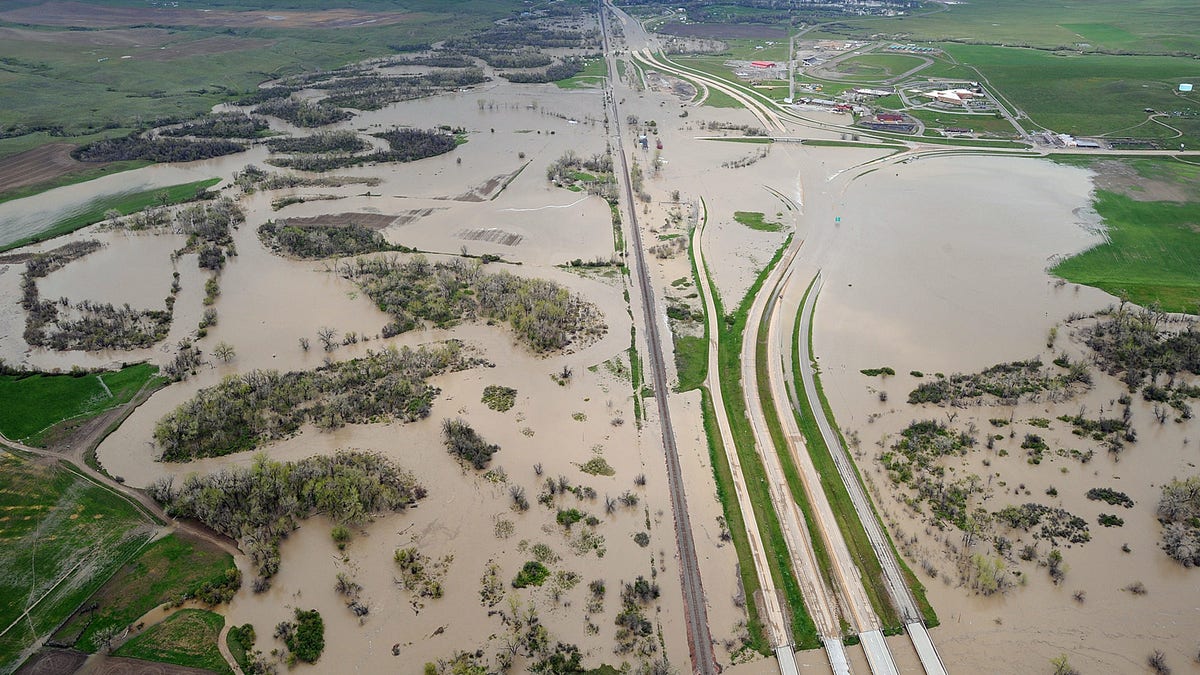
May 22: Flood water from the Little Bighorn River covers Interstate 90 near Crow Agency, Mont., in this aerial view on Sunday, May 22, 2011. (AP/The Billings Gazette) (AP2011)
CROW AGENCY, Mont. – Crow tribal officials sent search teams Wednesday to remote parts of their reservation to look for people stranded by flooding, as cities and towns across Montana tried to stave off rivers and streams spilling from their banks.
Flood waters in the hard-hit southeastern part of the state receded enough for Crow reservation residents to return to find dozens of homes damaged by the flooded Little Bighorn River. Tribal leaders scrambled to account for those who stayed behind and delivered food to more than 100 people in the Pryor area.
Help from the Montana National Guard was requested but there was no immediate word on when more aid might arrive. The tribe also requested food donations.
"There are families and elders still isolated and stranded in their homes," said tribe spokesman Donald Spotted Tail. "There's no way for them to access basic human needs such as food and water."
A 60-mile stretch of Interstate 90 that runs through the reservation to the Wyoming border reopened Wednesday after being closed for days. Officials are now able to move supplies to the community of Lodge Grass, which had been cut off and where people had been running low on food, water and fuel.
Tribal officials said the flooding has damaged at least 75 home, and about 150 people from the reservation remain at a shelter at Montana State University-Billings, along with another 43 people from outside Billings, according to the Bureau of Indian Affairs.
An unknown number of people from the nearby Northern Cheyenne reservation also have been evacuated because of concerns of flooding along the Rosebud Creek and Tongue River.
Workers filled sandbags in preparation for more flooding on the Crow reservation. Elijah LaForge, 24, estimated he has helped fill 4,000 sandbags over the past four days working for the tribe.
"I'm trying to make a little money to see if I can get myself a little house for me and my wife," he said.
LaForge said his own house in Benteen "was sitting on a lake" when he left it over the weekend. He hasn't been back and believes it may be lost.
Todd Chambers, a National Weather Service meteorologist based in Billings, said the threat of flooding remains in southeastern Montana even though rivers and streams there are expected to recede over the next several days.
"The problem is the soil. The soil is saturated. Having a two-, three-day break is not enough time to dry that soil out. If we get heavy rain into this weekend, we're going to have more problems," Chambers said.
A fast-moving storm is expected to pass through the state later this week, followed by another storm system early next week.
Flood warnings have been issued for 36 Montana counties as heavy rain and melting snowpack caused waterways across the state to rise rapidly. Most of the state is under some kind of flood advisory.
West of the Crow reservation, about a foot of water from the Rock Creek and Red Lodge Creek rushed through the streets of the small town of Joliet. About 100 houses -- a third of the total number of homes in town -- had taken in water in their basements or lower levels.
Residents laid sandbags outside their houses and pumped out their basements, though the water seemed to flow back in just as fast as it was jettisoned out.
Some said they were startled by just how quickly their town was overrun by water.
"At 8 o'clock this morning, the school crossing guard called and said you've got five minutes," said homeowner Roxy Reed. "And in five minutes it was here."
The nearby Cooney Reservoir was overflowing with up to 8 feet of water after Tuesday night's downpour, said volunteer fire chief Melvin Hoferer. The water began receding Wednesday afternoon and the flooding was expected to stop by midnight, he said.
In central and northern Montana, flooding was widespread in Fergus, Judith Basin, Petroleum, Phillips and Valley counties, where many roads were closed or washed out, according to the state Disaster and Emergency Services.
Residents in parts of Fergus County have been cut off by washed-out roads, officials said.
Rain caused a landslide early Wednesday near the eastern Montana town of Terry, shutting down the state's major southern cargo rail line, BNSF Railway spokesman Gus Melonas said Wednesday.
Eight feet of water covered the tracks of another rail line south of Billings near the Crow reservation, and large areas of track bed have been washed away, Melonas said.
The Clark Fork River above Missoula has reached flood stage, and warnings were in effect from the Yaak River in the far northwestern part of the state to the Bitterroot River in the far southwest.
Heavy rain was expected to fall across western Montana on Thursday and dump more water into the swollen waterways, according to the weather service.
The threat of flooding extended to Wyoming, Idaho and Utah.
In northern Utah, officials were examining a levee to prepare for a deliberate breach in an effort to ease pressure along the Weber River as it reaches flood levels.
Workers were planning to create hole in a levee at the Ogden Bay Refuge on the Weber River in northern Utah to help ease pressure on the structure by emptying water into the Great Salt Lake as levels could rise about a foot over the next two days.

